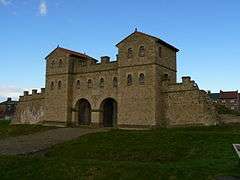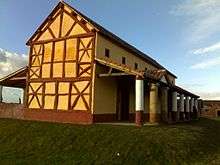Arbeia
Coordinates: 55°00′14″N 1°25′48″W / 55.004°N 1.430°W
| Arbeia Roman Fort and Museum | |
|---|---|
|
Reconstructed gateway | |
 Arbeia Roman Fort and Museum | |
| OS grid reference | NZ365679 |
| |
Arbeia was a large Roman fort in South Shields, Tyne & Wear, England, now ruined, and which has been partially reconstructed. It was first excavated in the 1870s and all modern buildings on the site were cleared in the 1970s. It is managed by Tyne and Wear Museums as Arbeia Roman Fort and Museum.
Original fort
The fort stands on the Lawe Top, overlooking the River Tyne. Founded around 120, it later became the maritime supply fort for Hadrian's Wall, and contains the only permanent stone-built granaries yet found in Britain. It was occupied until the Romans left Britain in the 5th century.
A possible meaning for "Arbeia" is "fort of the Arab troops", referring to the fact that part of its garrison at one time was a squadron of Mesopotamian boatmen from the Tigris. We also know that a squadron of Spanish cavalry, the First Asturian, was stationed there. It was common for forts to be manned by units originally from elsewhere in the empire, though often enough these would assimilate and end up by recruiting locally.
Museum
Two monuments in the museum at Arbeia testify to the cosmopolitan nature of its shifting population. One commemorates Regina, a British woman of the Catuvellauni tribe (approximately modern Hertfordshire). She was first the slave, then the freedwoman and wife of Barates, a merchant from Palmyra (now part of Syria) who, evidently missing her greatly, set up a gravestone after she died at the age of 30. (Barates himself is buried at the nearby fort of Coria (Corbridge).) The second commemorates Victor, another former slave, freed by Numerianus of the Ala I Asturum, who also arranged his funeral ("piantissime": with all devotion) when Victor died at the age of 20. The stone records that Victor was "of the Moorish nation".
The museum also holds an altarpiece to a previously unknown god and a tablet with the name of the Emperor Alexander Severus (died 235) chiselled off.
Reconstruction
A Roman gatehouse, barracks and Commanding Officer's house have been reconstructed on their original foundations. The gatehouse holds many displays related to the history of the fort, and its upper levels provide an overview of the archaeological site.
External links
| Wikimedia Commons has media related to Arbeia Roman fort. |


